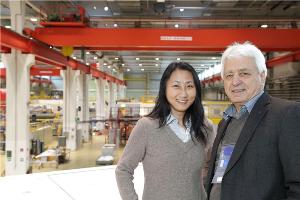Jan 27 2015
For more than 20 years, scientists at COSY have been investigating processes inside atomic nuclei. In 2015, the focus will turn to new questions. Hadron physics experiments will be pursued in future at the HESR storage ring at the international accelerator complex FAIR in Darmstadt. HESR is three times larger than COSY. At COSY, in contrast, preparations are under way for measuring fundamental symmetry violations.
The new projects will help us to understand where in the universe the vast amounts of antimatter disappeared to after the Big Bang. In addition, the Jülich accelerator will also be increasingly deployed for accelerator and detector development.
 Prof. Mei Bai and Prof. Hans Ströher from the Nuclear Physics Institute (IKP). Copyright: Forschungszentrum Jülich
Prof. Mei Bai and Prof. Hans Ströher from the Nuclear Physics Institute (IKP). Copyright: Forschungszentrum Jülich
“Since it was first put into operation in 1993, COSY has proven to be an extremely efficient tool for exploring the nature of the strong interaction, which is revealed in one of the properties of hadrons,” says Prof. Hans Ströher, director at the Nuclear Physics Institute. Hadrons include protons and neutrons, which are the building blocks of atomic nuclei. Since operation began, more than 500 weeks of beam time have been used for more than 200 experiments. A particularly memorable highlight was when scientists recently used Jülich’s cooler synchrotron (COSY) to prove the existence of an exotic particle made of six quarks for the very first time. For a long time, only bound states made of two or three of these elementary particles were known.
Solving a cosmic mystery
Starting in 2015, research at the 183-metre-long accelerator ring will turn to verifying fundamental symmetries. The new orientation goes hand in hand with the restructuring of the research field of the structure of matter within the Helmholtz Association, of which Forschungszentrum Jülich is a member. “The accelerator complex FAIR heralds new opportunities for hadron physics, and Jülich scientists are heavily involved in its construction,” says Hans Ströher, who is also head of Experimental Hadron Dynamics, explaining the decision.
Projects at COSY will help to solve the biggest mystery of them all, namely our existence. According to the conventional theory, the Big Bang should have created just as much matter as antimatter. But the two forms annihilate each other. In other words, we shouldn’t exist at all. Yet this is not the case: the annihilation was incomplete – and the violation of fundamental symmetries could explain why.
JEDI throws light on the matter
An international research group wants to use the experiment known as JEDI (Jülich Electric Dipole Investigations) to verify whether the proton possesses an electric dipole moment. This is created when the centre of mass of positive and negative electric charge carriers in the proton are separated from each other. The expected effect is almost unimaginably small. If the proton was as big as the Earth, then the distance between the two charge centres would be smaller than the diameter of a human hair. For such measurements, a variety of potential interferences must be considered, such as the force of gravity or the Earth’s magnetic field. In cooperation with RWTH Aachen University within the framework of the Jülich Aachen Research Alliance (JARA-FAME), scientists are running various preliminary studies at COSY. In the long term, the experiments are targeted at the construction of a novel storage ring, in which two proton beams will pass by each other in opposite directions.
New tools for new tasks
Over the next few years, a large proportion of the beam time at COSY will be reserved for developing devices and measuring techniques needed for the planned experiments. This work will be headed by Prof. Mei Bai. In December 2014, she came to Forschungszentrum Jülich from the Relativistic Heavy Ion Collider (RHIC) at Brookhaven National Laboratory, USA. “I am particularly interested in the scientific challenges associated with precision measurements with polarized proton beams,” says the new director at the Nuclear Physics Institute.
Accelerator and detector development will also benefit experiments with antiprotons at the international accelerator complex FAIR in Darmstadt. There, Jülich scientists are responsible for designing the 575-metre-long accelerator ring HESR and are also actively involved in the detector system PANDA. With a beam energy that is five times higher than that of COSY, the researchers will be able to use this facility to analyse heavy classes of quark bound states and to search for new exotic states. They are particularly interested in the existence of “glueballs”, which are not made of quarks as is usually the case, but rather exclusively of gluons. Gluons are the exchange particles of the strong interaction which are exchanged between quarks in a proton, for example. Pure glueballs have been theoretically predicted but have yet to be experimentally verified.